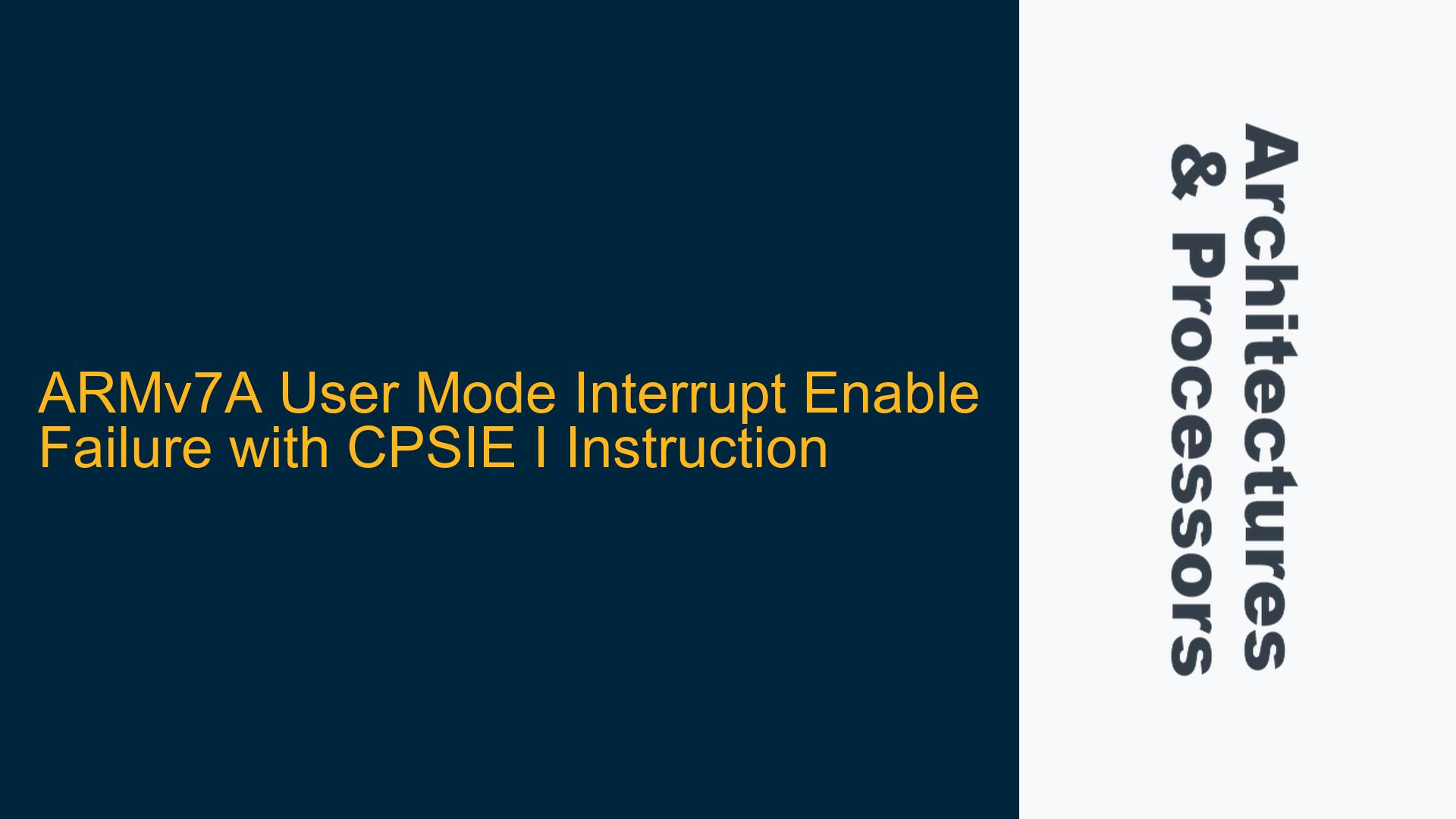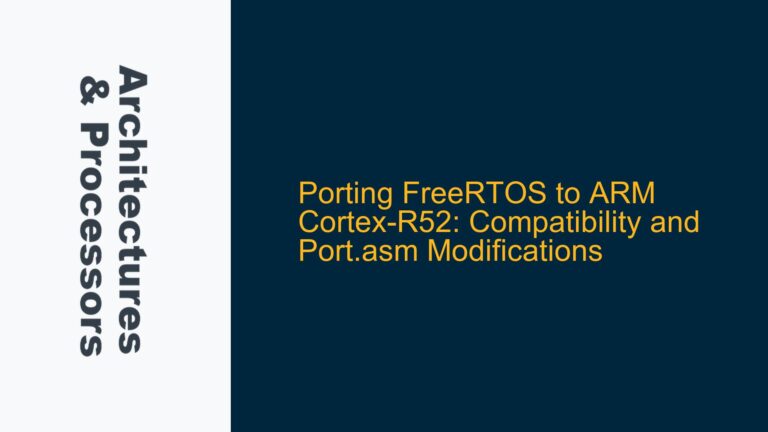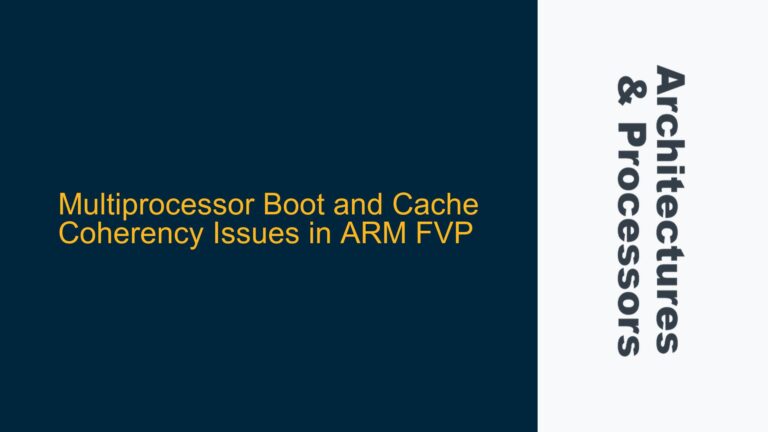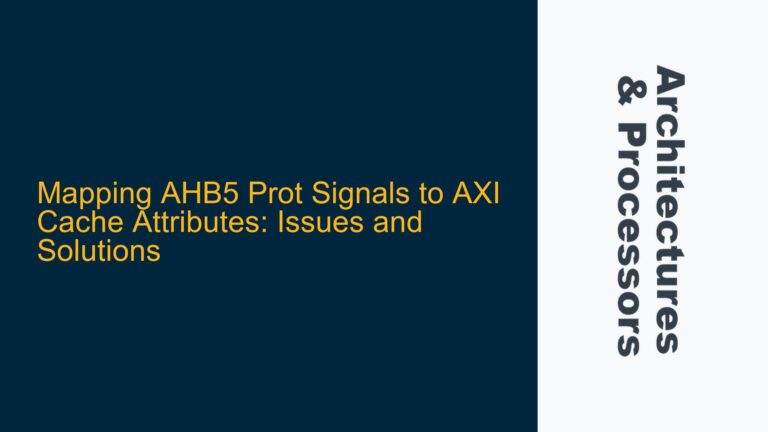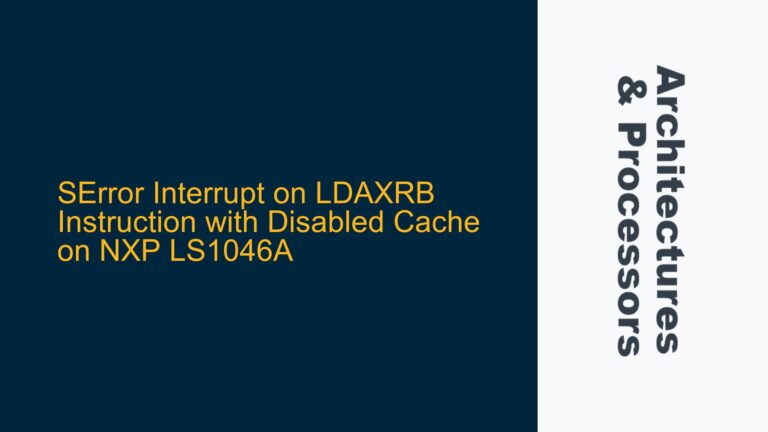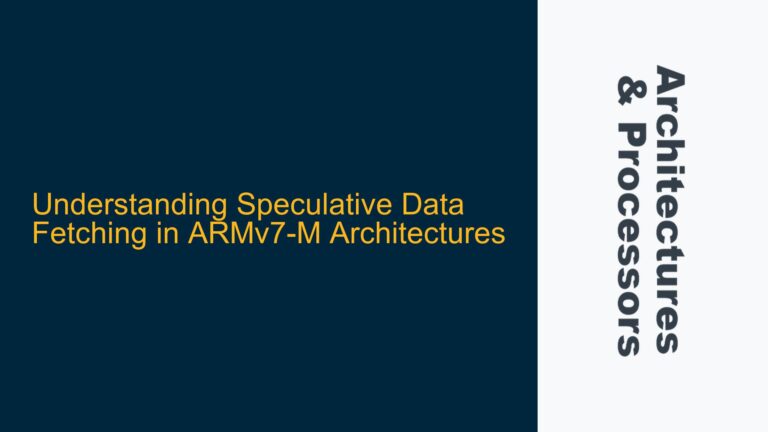ARMv7A User Mode Restrictions on CPSR.I Bit Modification
The ARMv7A architecture, particularly when operating in User mode, imposes specific restrictions on the modification of the Current Program Status Register (CPSR) interrupt masks, specifically the I bit. The I bit in the CPSR controls the enabling and disabling of interrupts. When the I bit is set to 1, interrupts are disabled; when it is set to 0, interrupts are enabled. However, in User mode, the architecture does not permit the modification of the I bit directly using instructions such as CPSIE I. This restriction is a fundamental aspect of the ARMv7A privilege model, designed to maintain system stability and security.
In User mode, the processor operates with limited privileges to prevent user applications from performing actions that could destabilize the system or interfere with the operating system’s operation. The inability to modify the I bit directly in User mode is one such restriction. This ensures that user applications cannot arbitrarily disable interrupts, which could prevent the operating system from regaining control of the processor. Consequently, any attempt to execute the CPSIE I instruction in User mode will not result in the I bit being modified, and interrupts will remain disabled.
The ARMv7A architecture provides several privileged modes, such as Supervisor (SVC) mode, which have the necessary permissions to modify the CPSR interrupt masks. To enable interrupts, the processor must transition from User mode to a privileged mode. This transition is typically facilitated by a system call, which is initiated using the Supervisor Call (SVC) instruction. The SVC instruction triggers an exception, causing the processor to switch to Supervisor mode, where the operating system can then handle the request to enable interrupts.
Privilege Level Constraints and System Call Necessity
The core issue stems from the privilege level constraints inherent in the ARMv7A architecture. User mode is designed to be a restricted execution environment where applications run with limited access to critical system resources and control registers. This design is intentional, as it prevents user applications from performing actions that could compromise system integrity or security. The CPSR interrupt masks, including the I bit, are among the resources that are protected from modification in User mode.
When an application running in User mode attempts to execute the CPSIE I instruction, the processor does not modify the I bit, and interrupts remain disabled. This behavior is consistent with the architecture’s design, which restricts User mode applications from directly controlling interrupt enablement. To enable interrupts, the application must request the operating system to perform the necessary action. This is achieved by making a system call, which transitions the processor to a privileged mode where the operating system can modify the CPSR interrupt masks.
The necessity of using a system call to enable interrupts highlights the importance of the operating system’s role in managing system resources and ensuring stable operation. By requiring applications to request interrupt enablement through a system call, the operating system can maintain control over interrupt handling and ensure that critical system functions are not disrupted by user applications.
Implementing SVC for Interrupt Enablement in ARMv7A
To enable interrupts in an ARMv7A processor running in User mode, the application must use the Supervisor Call (SVC) instruction to transition to a privileged mode where the CPSR interrupt masks can be modified. The SVC instruction triggers an exception, causing the processor to switch to Supervisor mode and execute the corresponding exception handler. The exception handler, which is part of the operating system, can then modify the CPSR to enable interrupts.
The process of implementing SVC for interrupt enablement involves several steps. First, the application must prepare the necessary parameters for the system call, which may include specifying the desired interrupt enablement state. The application then executes the SVC instruction, passing the system call number as an immediate operand. The processor responds by switching to Supervisor mode and jumping to the SVC exception handler.
The SVC exception handler examines the system call number and performs the requested operation. In this case, the handler would execute the CPSIE I instruction to enable interrupts. After modifying the CPSR, the handler returns control to the application, which continues execution with interrupts enabled. This process ensures that interrupt enablement is performed in a controlled manner, with the operating system maintaining oversight of critical system resources.
The use of SVC for interrupt enablement is a standard practice in ARMv7A systems, as it aligns with the architecture’s privilege model and ensures that user applications cannot arbitrarily modify the CPSR interrupt masks. By requiring applications to request interrupt enablement through a system call, the operating system can enforce security policies and maintain system stability.
Detailed Analysis of CPSR.I Bit Behavior in ARMv7A
The CPSR.I bit plays a critical role in controlling interrupt handling in the ARMv7A architecture. When the I bit is set to 1, interrupts are disabled, and the processor will not respond to interrupt requests. When the I bit is set to 0, interrupts are enabled, and the processor will handle interrupt requests as they occur. The behavior of the I bit is closely tied to the processor’s privilege level, with User mode applications restricted from modifying the I bit directly.
In User mode, the processor operates with limited privileges, and certain operations, such as modifying the CPSR interrupt masks, are prohibited. This restriction is enforced by the processor’s hardware, which prevents User mode applications from executing instructions that would modify the CPSR.I bit. As a result, any attempt to execute the CPSIE I instruction in User mode will not result in the I bit being modified, and interrupts will remain disabled.
The restriction on modifying the CPSR.I bit in User mode is a fundamental aspect of the ARMv7A architecture’s security model. By preventing User mode applications from directly controlling interrupt enablement, the architecture ensures that the operating system retains control over critical system resources. This design prevents user applications from disabling interrupts and potentially disrupting the operating system’s operation.
To enable interrupts, User mode applications must request the operating system to perform the necessary action. This is achieved by making a system call, which transitions the processor to a privileged mode where the operating system can modify the CPSR.I bit. The use of system calls for interrupt enablement ensures that the operating system maintains control over interrupt handling and can enforce security policies.
Transitioning to Privileged Mode for CPSR.I Bit Modification
Transitioning from User mode to a privileged mode is a key step in enabling interrupts in the ARMv7A architecture. The transition is initiated by executing the SVC instruction, which triggers an exception and causes the processor to switch to Supervisor mode. In Supervisor mode, the operating system has the necessary privileges to modify the CPSR.I bit and enable interrupts.
The process of transitioning to a privileged mode involves several steps. First, the application prepares the necessary parameters for the system call, which may include specifying the desired interrupt enablement state. The application then executes the SVC instruction, passing the system call number as an immediate operand. The processor responds by switching to Supervisor mode and jumping to the SVC exception handler.
The SVC exception handler examines the system call number and performs the requested operation. In this case, the handler would execute the CPSIE I instruction to enable interrupts. After modifying the CPSR, the handler returns control to the application, which continues execution with interrupts enabled. This process ensures that interrupt enablement is performed in a controlled manner, with the operating system maintaining oversight of critical system resources.
The transition to a privileged mode for CPSR.I bit modification is a standard practice in ARMv7A systems, as it aligns with the architecture’s privilege model and ensures that user applications cannot arbitrarily modify the CPSR interrupt masks. By requiring applications to request interrupt enablement through a system call, the operating system can enforce security policies and maintain system stability.
Role of the Operating System in Interrupt Enablement
The operating system plays a critical role in managing interrupt enablement in the ARMv7A architecture. By restricting User mode applications from directly modifying the CPSR.I bit, the architecture ensures that the operating system retains control over interrupt handling. This control is essential for maintaining system stability and security, as it prevents user applications from disabling interrupts and potentially disrupting the operating system’s operation.
When an application running in User mode needs to enable interrupts, it must request the operating system to perform the necessary action. This is achieved by making a system call, which transitions the processor to a privileged mode where the operating system can modify the CPSR.I bit. The operating system’s exception handler examines the system call number and performs the requested operation, such as executing the CPSIE I instruction to enable interrupts.
The operating system’s role in interrupt enablement extends beyond simply modifying the CPSR.I bit. The operating system is responsible for managing interrupt priorities, handling nested interrupts, and ensuring that critical system functions are not disrupted by user applications. By maintaining control over interrupt enablement, the operating system can enforce security policies and ensure that the system operates reliably.
The use of system calls for interrupt enablement is a standard practice in ARMv7A systems, as it aligns with the architecture’s privilege model and ensures that user applications cannot arbitrarily modify the CPSR interrupt masks. By requiring applications to request interrupt enablement through a system call, the operating system can maintain control over interrupt handling and enforce security policies.
Security Implications of CPSR.I Bit Modification in User Mode
The restriction on modifying the CPSR.I bit in User mode has significant security implications for the ARMv7A architecture. By preventing User mode applications from directly controlling interrupt enablement, the architecture ensures that the operating system retains control over critical system resources. This control is essential for maintaining system stability and security, as it prevents user applications from disabling interrupts and potentially disrupting the operating system’s operation.
If User mode applications were allowed to modify the CPSR.I bit directly, they could disable interrupts and prevent the operating system from regaining control of the processor. This could lead to a variety of security vulnerabilities, including denial-of-service attacks, where a malicious application disables interrupts and prevents the operating system from functioning correctly. By restricting User mode applications from modifying the CPSR.I bit, the ARMv7A architecture mitigates these risks and ensures that the operating system maintains control over interrupt handling.
The use of system calls for interrupt enablement is a key aspect of the ARMv7A architecture’s security model. By requiring applications to request interrupt enablement through a system call, the operating system can enforce security policies and ensure that critical system functions are not disrupted by user applications. This design aligns with the principle of least privilege, where applications are granted only the permissions necessary to perform their intended functions.
The security implications of CPSR.I bit modification in User mode highlight the importance of the operating system’s role in managing system resources and ensuring stable operation. By maintaining control over interrupt enablement, the operating system can enforce security policies and prevent user applications from compromising system integrity.
Practical Considerations for Implementing Interrupt Enablement
Implementing interrupt enablement in an ARMv7A system requires careful consideration of the architecture’s privilege model and the role of the operating system. User mode applications cannot directly modify the CPSR.I bit and must instead request the operating system to perform the necessary action. This is achieved by making a system call, which transitions the processor to a privileged mode where the operating system can modify the CPSR.I bit.
When implementing interrupt enablement, developers must ensure that the system call mechanism is correctly configured and that the operating system’s exception handler is capable of handling the request. This involves setting up the necessary exception vectors, configuring the SVC exception handler, and ensuring that the operating system can safely modify the CPSR.I bit.
Developers must also consider the impact of interrupt enablement on system performance and stability. Enabling interrupts can increase the processor’s interrupt handling overhead, which may affect the performance of time-critical tasks. Additionally, enabling interrupts inappropriately can lead to race conditions and other synchronization issues, particularly in multi-threaded applications.
To mitigate these risks, developers should carefully design their interrupt handling routines and ensure that interrupts are enabled only when necessary. This may involve using interrupt masking techniques, where interrupts are selectively enabled and disabled based on the application’s requirements. By carefully managing interrupt enablement, developers can ensure that their applications operate reliably and efficiently on ARMv7A systems.
Conclusion
The inability to modify the CPSR.I bit in User mode is a fundamental aspect of the ARMv7A architecture’s privilege model. This restriction ensures that User mode applications cannot arbitrarily disable interrupts and potentially disrupt the operating system’s operation. To enable interrupts, User mode applications must request the operating system to perform the necessary action, typically by making a system call using the SVC instruction.
The use of system calls for interrupt enablement aligns with the ARMv7A architecture’s security model and ensures that the operating system maintains control over critical system resources. By requiring applications to request interrupt enablement through a system call, the operating system can enforce security policies and maintain system stability.
Implementing interrupt enablement in an ARMv7A system requires careful consideration of the architecture’s privilege model, the role of the operating system, and the impact on system performance and stability. By following best practices and carefully managing interrupt enablement, developers can ensure that their applications operate reliably and efficiently on ARMv7A systems.
